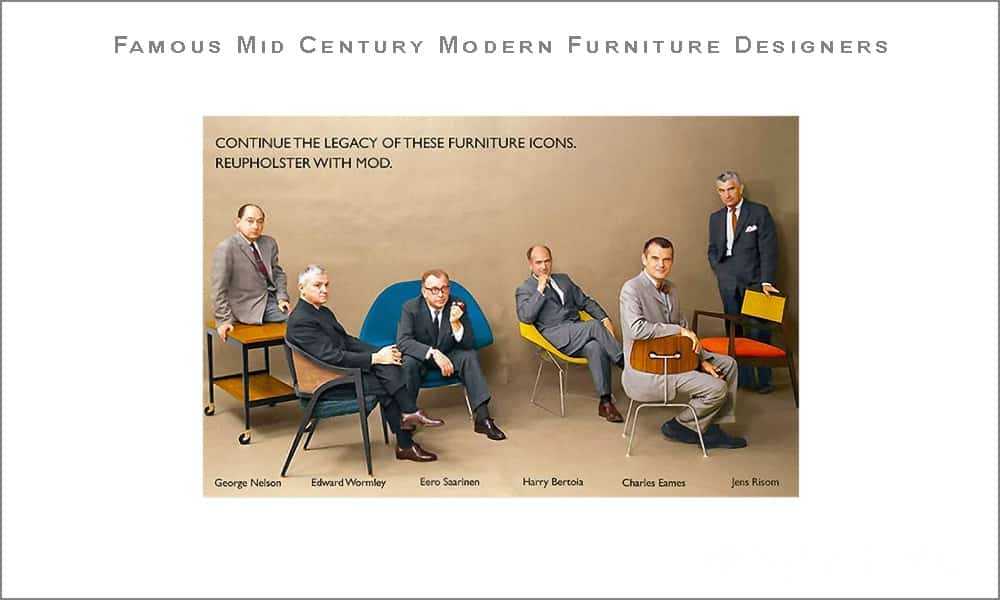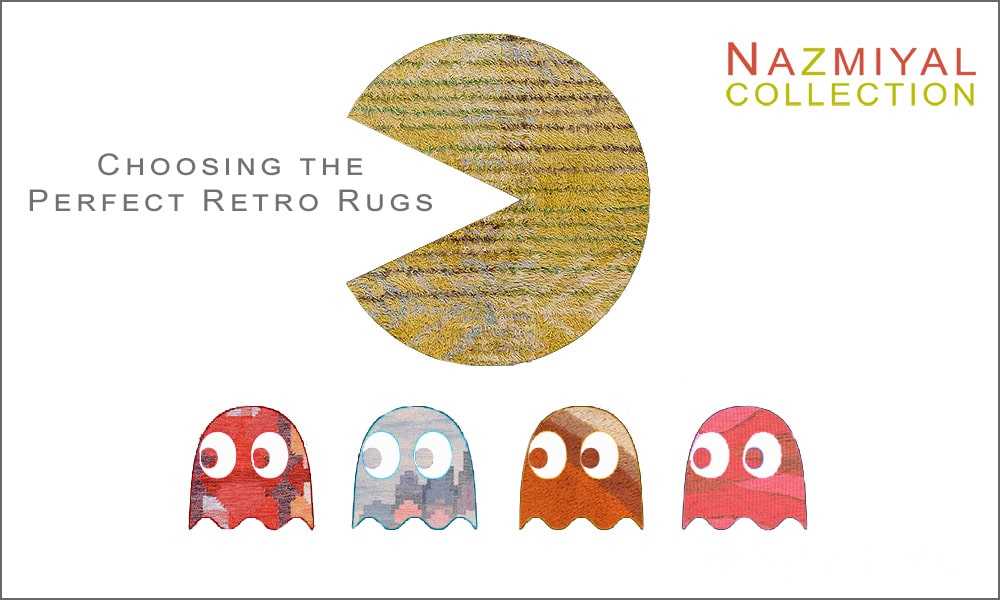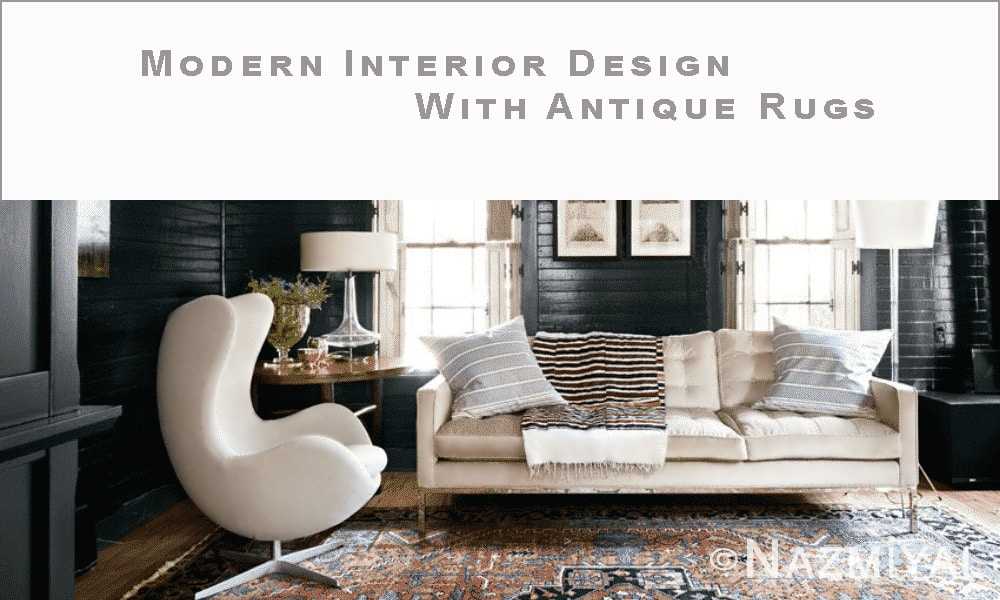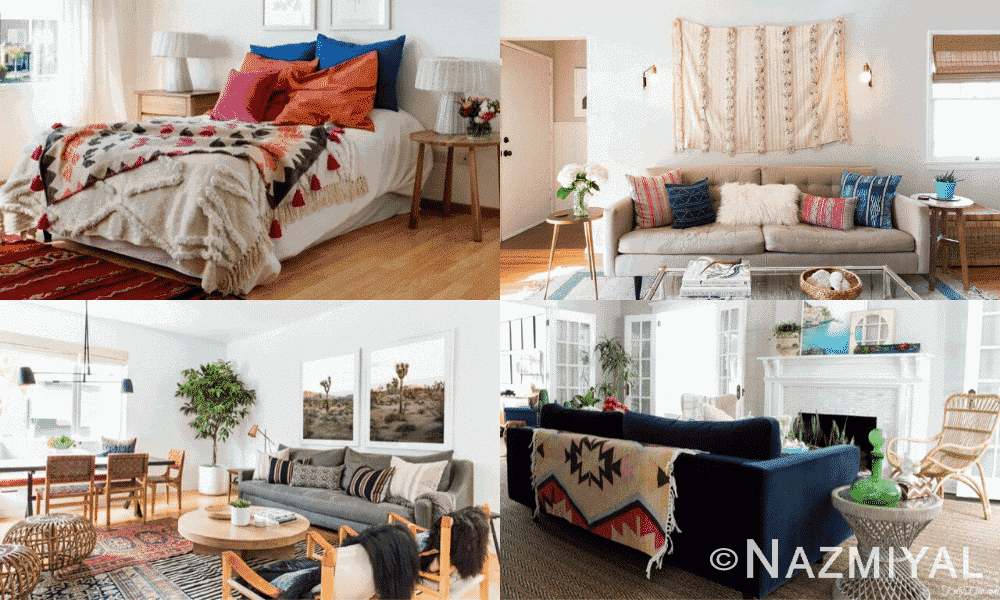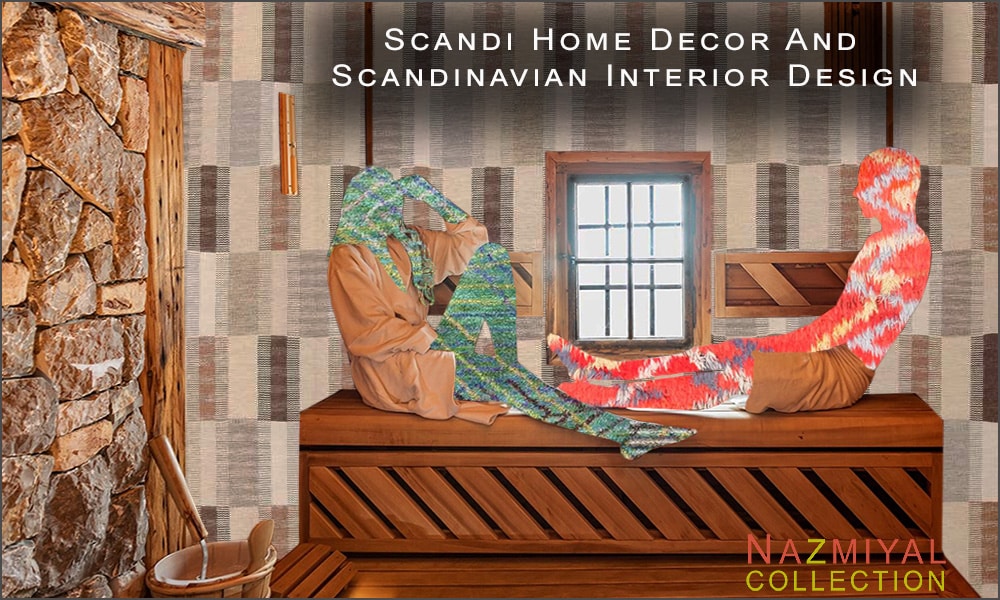Exploring Vintage Interior Design And Home Decor
Shop All Vintage Rugs | Shop All Modern Rugs | Shop All Antique Rugs | Create Your Own Unique Vintage Inspired Custom Area Rug
What is vintage interior design style?
Vintage interior design style refers to a decorating approach that draws inspiration from the aesthetics of past eras, typically from the early 20th century or earlier. This style aims to recreate the look and feel of a specific time period, often highlighting the charm, nostalgia, and uniqueness associated with those times. Vintage interior design is characterized by a mix of classic and antique elements, creating a sense of history and character in a space.
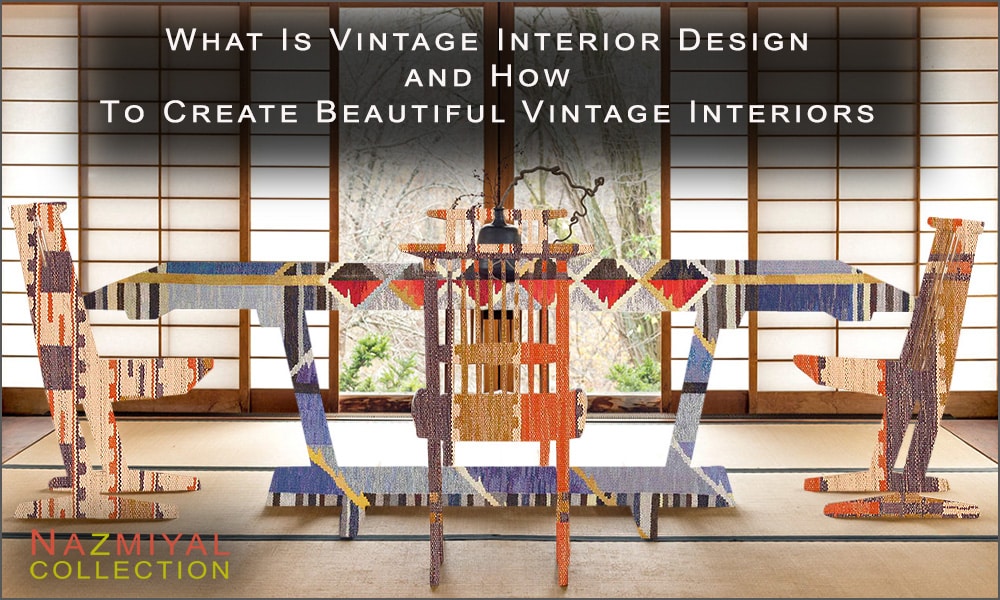
What Is Vintage Interior Design and How To Create Beautiful Vintage Interiors
Here are some key features and aspects of vintage interior design:
- Furniture: Vintage interiors often feature furniture pieces from different historical periods. These pieces might have ornate details, intricate carvings, and rich textures. Styles that are commonly incorporated include Victorian, Art Deco, Mid-Century Modern, and more.
- Color Palette: Vintage color palettes can vary depending on the chosen era. Warm, muted tones, pastels, and deep jewel tones are often used to create a sense of nostalgia. Earthy hues and rich, saturated colors can be found in different vintage design periods.
- Materials: Vintage design relies on natural materials like wood, stone, and metals. Antiqued or distressed finishes can add a weathered and aged appearance to furniture and decor.
- Patterns and Textiles: Floral prints, stripes, damask, and paisley are common patterns in vintage interiors. Heavy, luxurious fabrics like velvet and silk can be used for upholstery and curtains.
- Accessories: Vintage decor often includes a mix of accessories such as vintage clocks, ornate mirrors, crystal chandeliers, porcelain figurines, and antique books. These items help evoke the feeling of stepping back in time.
- Wall Treatments: Wallpaper with intricate patterns or classic motifs is a common choice in vintage interiors. Wainscoting, beadboard, and other traditional wall treatments might also be incorporated.
- Lighting: Lighting fixtures in vintage interiors can vary widely based on the chosen era. Chandeliers, sconces, and lamps with decorative shades or stained glass are often used to add a touch of elegance and history.
- Details: Paying attention to small details like doorknobs, hinges, and handles can help maintain the vintage aesthetic throughout a space.
- Mix and Match: Vintage interior design often involves combining pieces from different time periods and styles, creating an eclectic and curated look.
- Personal Touch: While vintage interior design draws inspiration from the past, it’s important to infuse your personal style into the space to make it feel uniquely yours.
It’s worth noting that vintage interior design can cover a wide range of eras and styles, so there’s flexibility in how you interpret and apply it to your space. Whether you’re aiming for the elegance of the Victorian era or the sleek lines of seen of the German Bauhaus architecture style as well as Mid-Century Modern, vintage interior design allows you to create a space that’s full of character and history.
Learn more: What is natural material rug vs an unnatural synthetic area rug? | Victorian House and Architecture Styles | Victorian Rugs, Interiors and History | Exploring The Mid Century Modern Design Style | Famous Mid Century Modern Furniture Designers | Eclectic Interior Design With Area Rugs
When talking about interior design only – what period of time would “vintage” fall under?
In the context of interior design, the term “vintage” typically refers to design styles and aesthetics from the early 20th century to around the 1980’s.
The broad “vintage” time span encompasses a variety of design movements, including:
- Victorian Era (1837-1901): While not considered “vintage”, some elements from the late Victorian era can be included, particularly in the early 20th century designs. This era is characterized by ornate and heavily decorated interiors.
- Art Nouveau (Late 19th to Early 20th Century): Known for its organic and flowing forms, the Art Nouveau influence can be seen in vintage designs from the late 19th century and early 20th century.
- Art Deco (1920’s-1930’s): Art Deco is a prominent vintage style that emphasizes geometric shapes, bold colors, and luxurious materials. It’s known for its glamour and sophistication.
- Mid-Century Modern (1930’s-1960’s): This style emerged in the mid-20th century and is characterized by clean lines, functional design, and a focus on simplicity. It has experienced a resurgence in popularity in recent years.
- 1950’s and 1960’s: The post-World War II era saw the rise of suburban living and the influence of mid-century modern and other styles. Pastel colors, Formica furniture, and kitschy decor are associated with this time.
- 1970’s and 1980’s: These decades are the core of what most people think of as “vintage”. This time period brought a diverse range of design trends, from the earthy and organic styles of the 1970’s to the bold and colorful designs of the 1980’s.
The vintage period can vary depending on individual perspectives, but generally, it encompasses design aesthetics that have a nostalgic and historical charm, while still being relatively recent compared to earlier historical periods. Keep in mind that the boundaries of what is considered “vintage” can be flexible and can change as time goes on, influenced by trends and shifts in design preferences.
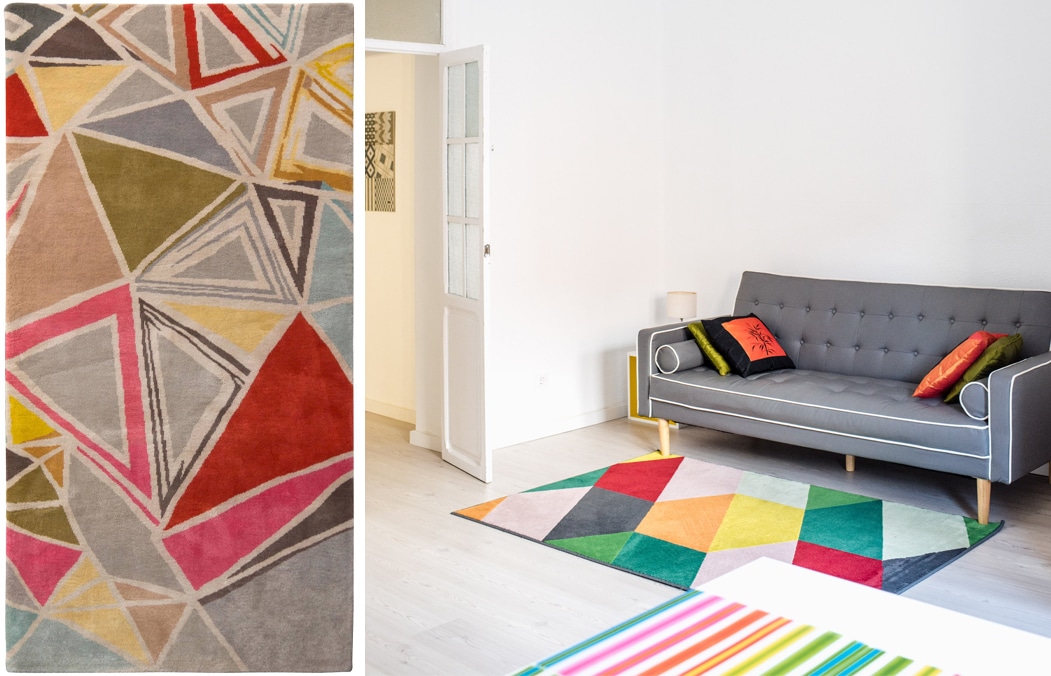
Colorful Mid Century Modern Design Area Rug
Shop Art Nouveau Rugs | Shop Art Deco Rugs | Shop Mid Century Modern Design Rugs
What is the difference between vintage and retro interior design?
Vintage and retro interior design are related styles that both draw inspiration from the past, but they have distinct characteristics and focus on different time periods.
Here’s how vintage and retro they differ:
Vintage Interior Design:
- Time Period: Vintage interior design refers to styles that evoke the aesthetic of a specific historical period, typically from the early 20th century to the 1980s. It aims to recreate the ambiance, decor, and overall feel of that era.
- Authenticity: Vintage design often uses authentic or reproduction items from the chosen era. This can include original furniture, decor, and accessories that are true to the period’s design principles.
- Attention to Detail: Vintage design pays close attention to historical accuracy and authenticity, with an emphasis on using genuine materials and design elements from the era.
- Mixing Styles: Vintage interiors may mix and match pieces from different periods to create an eclectic look that reflects the homeowner’s personal tastes and preferences.
- Color Palette: The color palette in vintage design can vary based on the chosen era, but it often features subdued and muted tones, pastels, and earthy colors.
- Patterns and Textiles: Vintage interiors incorporate patterns and textiles that were popular during the specific time period. Examples include floral prints, damask, and intricate patterns.
Retro Interior Design:
- Time Period: Retro interior design refers to styles that are inspired by relatively recent past decades, usually from the 1950’s to the 1980’s. It often highlights the pop culture and design trends of those decades.
- Nostalgic Elements: Retro design focuses on nostalgic elements that evoke a sense of fun and playfulness associated with the chosen era. This can include iconic items and motifs from the past.
- Bold and Playful: Retro design tends to be more whimsical and vibrant compared to vintage design. It incorporates bold colors, patterns, and unique shapes that were characteristic of the retro era.
- Reinterpretation: Retro interiors reinterpret and reimagine the past, often with a modern twist. They may incorporate contemporary materials and technologies while maintaining a retro aesthetic.
- Pop Culture References: Retro design often integrates pop culture references, such as iconic posters, advertisements, and motifs from movies, music, and TV shows of the chosen era.
- Furniture and Decor: Retro interiors may include furniture and decor items that capture the essence of the era, such as mid-century modern furniture, bright plastic chairs, and shag rugs.
In summary, vintage interior design is focused on accurately recreating the look and feel of a specific historical period, while retro interior design takes a more playful and nostalgic approach to capturing the essence of relatively recent past decades. Both styles offer opportunities for personal expression and creativity by blending elements from the past with contemporary design sensibilities.
Learn more: Choosing Retro Rugs For Your Home Decor | Exploring Vintage Glam Decor and Interior Design | 5 Things You Probably Didn’t Know About Vintage Rugs
Shop Pop Art Rugs | Shop Bold Rugs
What is the difference between vintage and modern interior design?
Vintage and modern interior design are two distinct styles that represent different approaches to decorating and creating living spaces.
Here’s a comparison of vintage vs modern interiors:
Vintage Interior Design:
- Time Period: Vintage design draws inspiration from past decades, typically from the early 20th century to around the 1980s, depending on the specific era being referenced.
- Aesthetic: Vintage interiors aim to recreate the look and feel of a particular historical period. They often feature ornate details, intricate patterns, and a sense of nostalgia.
- Furniture: Vintage furniture tends to have classic and sometimes ornate designs. Pieces from different eras may be mixed together to create an eclectic look.
- Materials: Natural materials like wood, metal, and textiles are commonly used in vintage interiors. These materials contribute to the sense of history and authenticity.
- Color Palette: Vintage color palettes can vary based on the chosen era, but they often include muted tones, pastels, and rich jewel colors.
- Patterns and Textures: Vintage interiors incorporate a variety of patterns, such as florals, damask, and intricate motifs. Textiles with rich textures are also commonly used.
- Accessories: Vintage decor includes a mix of antique and period-specific accessories, such as vintage clocks, porcelain figurines, and ornate mirrors.
- Lighting: Lighting fixtures in vintage interiors can range from crystal chandeliers to Art Deco-inspired lamps, adding a touch of elegance and historical charm.
Modern Interior Design:
- Time Period: Modern design refers to the design principles and aesthetics that emerged in the early to mid-20th century, with an emphasis on the mid-century modern era (1930s-1960s).
- Aesthetic: Modern interiors focus on clean lines, minimalism, and functionality. The design philosophy emphasizes simplicity, form follows function, and the elimination of unnecessary ornamentation.
- Furniture: Modern furniture features sleek, simple lines and geometric shapes. Functionality and innovative materials are often emphasized.
- Materials: Modern design incorporates a range of materials, including glass, steel, and molded plastics. These materials reflect the technological advancements of the time.
- Color Palette: Modern interiors often use neutral color palettes with pops of bold and vibrant colors. White, black, and natural wood tones are common.
- Patterns and Textures: Modern design typically focuses on clean and uncluttered surfaces, often avoiding intricate patterns and textures.
- Accessories: Modern interiors tend to have minimal and purposeful accessories. Decorative elements are kept to a minimum, with a focus on functional pieces.
- Lighting: Modern lighting fixtures often feature clean and geometric shapes. Pendant lights, floor lamps, and table lamps with innovative designs are common.
In summary, vintage interior design embraces historical charm, ornate details, and a sense of nostalgia, while modern interior design emphasizes simplicity, clean lines, and functionality. The choice between these two styles depends on personal preferences, the desired ambiance, and the overall aesthetic one wishes to create within their living space.
Learn More: Create Captivating Modern Interiors With Modern Vintage And Antique Area Rugs | Modern Rugs In Manhattan Celebrities Homes | New Contemporary Modern Area Rugs | Modern Rug Trends | Modern Area Rug Styles | 5 Tips For Using New Modern Area Rugs In Contemporary Decor | How To Care For Your Modern Rugs
How do you style a vintage room?
Styling a vintage room involves carefully curating and arranging furniture, decor, and accessories to create a space that reflects the aesthetics of a particular historical era.
Here’s a step-by-step guide on how to style a vintage room:
- Choose an Era: Decide on the specific era or time period you want to emulate in your vintage room. This will guide your design choices and help create a cohesive look.
- Select Furniture: Look for furniture pieces that are characteristic of the chosen era. For example, if you’re going for a Mid-Century Modern vibe, opt for furniture with clean lines, tapered legs, and iconic designs. If it’s an Art Deco theme, choose furniture with geometric shapes and luxurious materials.
- Consider Color Palette: Research the color palette that was popular during the chosen era. Select paint colors, wallpapers, and fabrics that align with those historical color trends.
- Choose Fabrics and Textiles: Incorporate fabrics and textiles that were common in that time period. Look for upholstery fabrics, curtains, and linens with patterns and textures that reflect the vintage style.
- Add Vintage Decorative Details:
- Wall Treatments: Consider using wallpaper with period-appropriate patterns or decorative moldings.
- Accessories: Select vintage accessories such as antique clocks, figurines, vases, and decorative trays that fit the chosen era.
- Artwork: Hang vintage artwork or reproductions that reflect the art styles of the era.
- Mirrors: Choose mirrors with ornate frames or geometric shapes that align with the vintage style.
- Lighting: Select lighting fixtures that capture the essence of the era. Crystal chandeliers for a Victorian feel, sleek mid-century pendant lights, or Art Deco-inspired sconces are some options.
- Arrange Furniture: Place furniture in a way that complements the flow of the room. Ensure that furniture pieces are proportionate and balanced within the space.
- Layer Textiles: Layer textiles on furniture, such as adding throw pillows and cushions with vintage-inspired patterns. Consider using vintage-style rugs to define different areas of the room.
- Mix and Match: Feel free to mix and match furniture pieces from different periods within the chosen era. This can add depth and character to the space.
- Pay Attention to Details: Add smaller details such as vintage doorknobs, drawer pulls, and switch plates that contribute to the overall vintage feel.
- Personalize the Space: Infuse your personal style into the room by adding items that have sentimental value or reflect your tastes.
- Balance with Modern Touches: While creating a vintage room, it’s also important to balance the design with modern amenities and comforts. Incorporate modern elements like comfortable seating, technology, and conveniences.
- Edit and Adjust: Step back and assess the overall look. Make adjustments as needed to ensure that the room feels harmonious and visually pleasing.
Remember that styling a vintage room is about capturing the essence of a particular era while still reflecting your personal preferences. It’s a creative process that allows you to blend history with contemporary design sensibilities.
Learn More: Layering Rugs On Top Of Other Rugs In Interior Design And Home Decor | Vintage Verner Panton Textile Fabrics | How To Use Rugs To Add Color And Transform Your Home Decor
What types of area rugs work best in vintage themed interior designs?
When it comes to choosing the perfect area rugs for a vintage-themed interior design, it’s important to select area rug styles that complement the overall aesthetic of the era you’re trying to evoke.
Here are some types of area rugs that work well in vintage-themed interior designs:
- Oriental and Persian Rugs: These rugs often feature intricate patterns, rich colors, and elaborate designs that can complement vintage styles like Victorian, Art Deco, and even some mid-century designs.
- Vintage-inspired Patterns: Look for rugs that feature classic patterns like damask, floral motifs, and geometric designs. These patterns are reminiscent of different vintage periods and can add a touch of nostalgia.
- Antique Rugs: If you can find authentic antique rugs, they can add a genuine vintage touch to your space. These rugs often have unique designs and worn-in textures that fit well with vintage aesthetics.
- Kilim or Flatweave Rugs: Kilim rugs with their geometric patterns and vibrant colors can be a great addition to mid-century modern or bohemian vintage themes.
- Shag Rugs: Shag rugs were popular in the 1960s and 1970s, making them suitable for retro and groovy vintage styles. They add texture and comfort to the space.
- Natural Fiber Rugs: Vintage interiors often incorporate natural materials. Jute, sisal, or seagrass rugs can complement rustic and shabby-chic vintage designs.
- Rugs with Faded Colors: Shabby Chic rugs, as in area rugs with a distressed or faded appearance can capture the weathered and aged look associated with vintage interiors.
- Tone-on-Tone Rugs: These rugs have subtle variations in color that create a timeless and elegant look, which can suit a variety of vintage styles.
- Art Deco Rugs: For Art Deco-themed spaces, consider rugs with bold geometric patterns, high contrast, and a touch of luxury.
- Pastel-colored Rugs: Soft pastel colors are often associated with vintage designs. Rugs in pale pinks, blues, and yellows can work well in rooms inspired by different eras.
- Classic Border Rugs: Rugs with classic borders and traditional designs can align with the aesthetics of Victorian and Edwardian eras.
- Geometric Patterns: For mid-century modern themes, look for rugs with clean lines and geometric shapes that were popular during that era.
When selecting area rugs for your vintage-themed interior, pay attention to the color palette, pattern, and overall vibe of the space. It’s important for the rug to harmonize with other elements in the room while contributing to the vintage atmosphere you’re trying to create.
In addition… Scandinavian rugs and Swedish rugs can be excellent additions to vintage-themed interior designs, particularly if you’re aiming for a Nordic or Scandi / Scandinavian interior design and home decor style. These types of area rugs often feature simple yet timeless designs that can enhance the overall ambiance of your vintage-themed room.
Here’s how Scandinavian and Swedish rugs can work within different vintage aesthetics:
Scandinavian Vintage Style:
- Nordic Patterns: Scandinavian rugs often showcase minimalistic patterns and geometric designs. These can align well with a mid-century modern or minimalist vintage style.
- Neutral Colors: Look for rugs with neutral color palettes, such as grays, whites, and earthy tones. These colors create a calming and serene atmosphere that’s characteristic of Scandinavian design.
- Wool and Natural Fibers: Scandinavian rugs are often made from natural materials like wool. The tactile qualities of these rugs can contribute to the cozy and inviting feel of a vintage Scandinavian interior.
Swedish Vintage Style:
- Soft Color Palettes: Swedish rugs are known for their delicate and pastel color schemes. These rugs can work beautifully in vintage interiors inspired by the Gustavian or Swedish Rococo styles.
- Floral and Botanical Motifs: Many Swedish rugs feature floral or botanical motifs. These can enhance the vintage charm of a room, particularly if you’re aiming for a romantic or shabby-chic vintage style.
- Light and Airy Aesthetics: Swedish design often emphasizes light and airy interiors. Choose rugs to place in your interior that contribute to this sense of space and openness.
Incorporating Scandinavian and Swedish rugs into your vintage-themed interior can provide a fresh and unique twist on traditional vintage design. These beautiful area rugs can add a touch of elegance, simplicity, and craftsmanship that align with the aesthetics of Northern European design traditions. As always, make sure the rug you choose complements the overall look and feel you’re aiming for in your vintage-themed space.
Learn More: The Swedish Rug | Oriental Rugs Explained | The Handcrafted Persian Area Rug | Vintage Shag Pile Swedish Rya Rug History | Home Decorating With Geometric Area Rugs | Bauhaus School and Scandinavian Design | Tips For Home Decorating With Scandinavian Area Rugs | Exploring Swedish Scandinavian Folk Art Traditions and Motifs
Shop Persian Rugs | Shop Vintage Swedish Shag Pile Rya Rugs | Shop Kilim Rugs | Shop Modern Flatweave Rugs | Shop Geometric Rugs | Shop Oriental Rugs | Shop Marta Maas Fjetterstrom Rugs | Shop Neutral Area Rugs | Shop Pastel Rugs | Shop Floral Rugs | Shop Wool Rugs
This interior design blog about vintage interior design and how to create beautiful interiors was published by Nazmiyal Rugs

